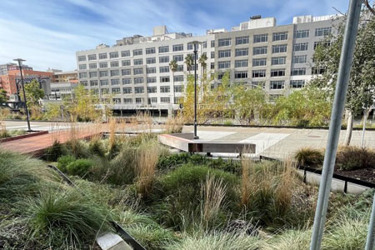Stormwater Management Is A Worldwide Challenge

By Jim Lauria

Last month, I wrote about San Francisco's great rain garden/bio-retention basin project. Strategically placed sunken curb cuts, swales, or park features collect stormwater and let it filter into the ground, reducing the pressure on overwhelmed storm drains and sewers.
The City by the Bay is doing a great job, and it's inspiring to look at communities that are leading the way with bigger, even more innovative projects.
For instance, other areas of California are grappling with the same challenges of managing both flood and drought. Policymakers, environmentalists, farmers, and other stakeholders are grappling over proposals to capture stormwater in mountain reservoirs. Those projects, with massive price tags and steep environmental costs, are political quicksand and will be debated for more years, or decades, to come. Meanwhile, closer to the ocean and cut off from the reservoirs of the mountains or the magnificent canal systems of the Central Valley, places like the Pajaro Valley, east of Monterey Bay, look down, not up, when considering water storage.
Andrew Fisher at University of California, Santa Cruz is leading an innovative aquifer recharge project in the Pajaro Valley, which he notes relies on groundwater for 83% of its water needs. Guiding winter floodwaters to areas where it can be held until it soaks into the ground can be a crucial way to rebuild water reserves for the farms and communities in the area. Think of it as a massive version of a bio-retention planter or bio-swale.
Great Cities, Great Projects
Back on the urban level...if you like what San Francisco is doing with its basins and swales, you'll love these innovative city stormwater projects.
Copenhagen, Denmark, has developed city lakes and a new channel to handle stormwater. Bangkok, Thailand, has buried massive tanks to capture floods.
Right down the road from San Francisco, Santa Clara Valley Water recently engineered 4.5 acres of Mountain View's McKelvey Park into a beautiful and functional stormwater capture basin. The baseball diamonds are sloped to 18 feet below grade, forming a huge catcher's mitt that can snag a 50-year flood and hold it until it drains out safely over several days. The utility says McKelvey Park protects more than 2,200 properties in Mountain View and Palo Alto from flooding. In fact, 660 parcels in the neighborhood have been removed from the Federal Emergency Management Agency (FEMA) Flood Insurance Rate Map since the park's catch basin was built. That not only protects property, it saves the property owners millions of dollars in insurance premiums.
But for sheer scale, brilliance, and engineering panache, nothing beats the Stormwater Management and Road Tunnel (SMART) in Kuala Lumpur, Malaysia. The bustling capital city tackled two problems at once: snarled traffic entering the south side of the city and annual bouts of flooding during monsoon season. The solution: an ingenious tunnel that doubles as a traffic bypass in dry weather and a stormwater diversion and storage tank in storms.
The 43-foot-diameter tunnel in 6 miles long in total, including 2.5 miles of underground motorway. The car tunnel portion has three layers — two one-way traffic layers over a stormwater channel. When storms bring in more water than the bottom layer can accommodate, operators close the tunnel to traffic and allow it to fill with water. Over the next couple of days, the SMART tunnel holds, then steadily drains, the stormwater, saving the city from deep floods that have plagued it for generations.
Impressed? Consider the scale. The tunnel has a capacity of 1 cubic kilometer of water. That's 264 billion gallons. The reservoirs on either end of it can hold up to twice that volume. On top of all that water management, it also bypasses a 15-minute traffic snarl with a 4-minute express lane trip into town. As someone who has spent way more than his share of time in San Francisco traffic, I can certainly appreciate that bonus, too.
It's Time
Perhaps the biggest testimony to the brilliance of projects like SMART is the fact that just three weeks after it was inaugurated, the tunnel was put to work handling its first flood. All of us, whether we're watching the monsoons in Malaysia, the atmospheric rivers over California, or thunderstorms over the Great Plains, have a stake in good stormwater management. Let's learn from these leaders.
